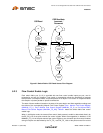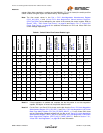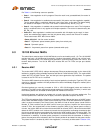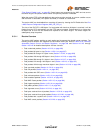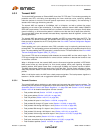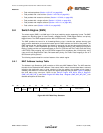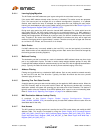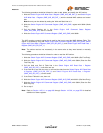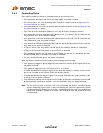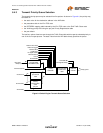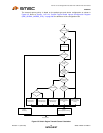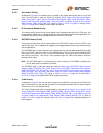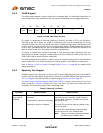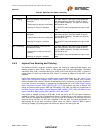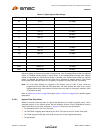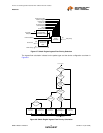
Two Port 10/100 Managed Ethernet Switch with 16-Bit Non-PCI CPU Interface
Datasheet
Revision 1.4 (08-19-08) 66 SMSC LAN9311/LAN9311i
DATASHEET
6.4.2 Forwarding Rules
Upon ingress, packets are filtered or forwarded based on the following rules:
If the destination port equals the source port (local traffic), the packet is filtered.
If the source port is not in the forwarding state, the packet is filtered (unless the Spanning Tree
Port State Override is in effect).
If the destination port is not in the forwarding state, the packet is filtered (unless the Spanning Tree
Port State Override is in effect).
If the Filter bit for the Destination Address is set in the ALR table, the packet is filtered.
If the packet has a unicast destination MAC address which is not found in the ALR table and the
Drop Unknown bit is set, the packet is filtered.
If the packet has a multicast destination MAC address which is not found in the ALR table and the
Filter Multicast bit is set, the packet is filtered.
If the packet has a broadcast destination MAC address and the Broadcast Storm Control level has
been reached, the packet is discarded.
If Drop on Yellow is set, the packet is colored Yellow, and randomly selected, it is discarded.
If Drop on Red is set and the packet is colored Red, it is discarded.
If the destination address was not found in the ALR table (an unknown or a broadcast) and the
Broadcast Buffer Level is exceeded, the packet is discarded.
If there is insufficient buffer space, the packet is discarded.
When the switch is enabled for VLAN support, these following rules also apply:
If the packet is untagged or priority tagged and the Admit Only VLAN bit for the ingress port is set,
the packet is filtered.
If the packet is tagged and has a VID equal to FFFh, it is filtered.
If Enable Membership Checking on Ingress is set, Admit Non Member is cleared, and the source
port is not a member of the incoming VLAN, the packet is filtered.
If Enable Membership Checking on Ingress is set and the destination port is not a member of the
incoming VLAN, the packet is filtered.
If the destination address was not found in the ALR table (as unknown or broadcast) and the VLAN
broadcast domain containment resulted in zero valid destination ports, the packet is filtered.
Note: For the last three cases, if the VID is not in the VLAN table, the VLAN is considered foreign
and the membership result is NULL. A NULL membership will result in the packet being filtered
if Enable Membership Checking is set. A NULL membership will also result in the packet being
filtered if the destination address is not found in the ALR table (since the packet would have
no destinations).



